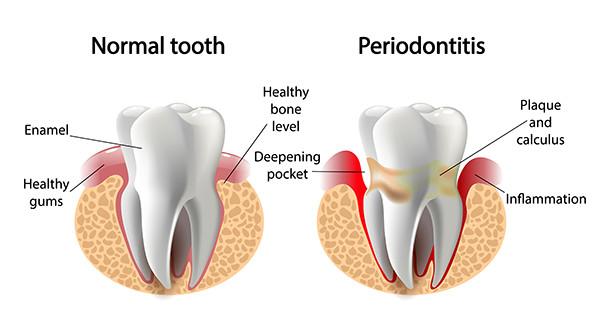Gum Disease
Many people don’t pay as much attention to their gums as they should. Gum care is important because the gums are part of what anchors the teeth. A person who has advanced gum disease, or periodontal disease can lose teeth that are otherwise healthy because the scaffolding that holds the teeth in place is destroyed.
The Early Stages of Gum Disease
Gingivitis is the first stage of gum disease. It’s an inflammation of the gums and happens because plaque, a film of bacteria, is not removed from the surface of the teeth. The bacteria in the plaque proliferates as it is nourished by foods and sugars. As the plaque accumulates, it can be harder and harder for a layperson to remove it. That's why it’s important that they see a dentist at least once a year for cleaning.
If gingivitis isn’t treated, the gums become tender, sensitive and start to bleed. People start to see blood in their sink or on their tooth brush when they brush their teeth. If the condition isn’t corrected, the inflammation attacks the structures that support the teeth. In this way, gingivitis proceeds to periodontitis.
Periodontitis
Periodontitis has three stages. In the first stage, the plaque on the tooth hardens and begins to penetrate beneath the patient’s gum line. This causes the gums to pull away from the tooth, which creates pockets that are good places for bacteria to accumulate and multiply. The bacteria produce toxins that start to degrade the bone and tissue that stabilize the tooth.
By the third phase of periodontitis, the patient’s gums have so receded that there are very deep pockets of 4 millimeters or more between the teeth. This causes the roots of the teeth to be exposed. The load of bacteria and their poisons causes infections, and finally the tissue, bone and other structures that have kept the teeth in place are destroyed, and the teeth are in danger of being lost.
Treatment
Treatment of periodontal disease is performed by a gum disease dentist, or periodontist. Their job is to clean the infection and save the patient’s teeth. To do this, the gum disease dentist performs scaling and root planing. When the teeth are scaled, the plaque is removed from above and below the gum line. Planing is smoothing out the rough areas of the roots of the teeth, for bacteria adhere to rough surfaces more than they do to smooth ones. Planing also allows gums to reattach themselves to the tooth. The patient is given a local anesthetic during the treatment. It may take more than one visit to the periodontist to treat periodontal disease.
After the procedure, the patient is given special medicines to help their gums heal. They visit the periodontist regularly for teeth-cleaning and to make sure their gums are healing.
Surgery is an option if conservative methods don’t work. Surgery to correct periodontal disease may involve implants, bone and soft tissue grafting and crown lengthening.
Hygiene
